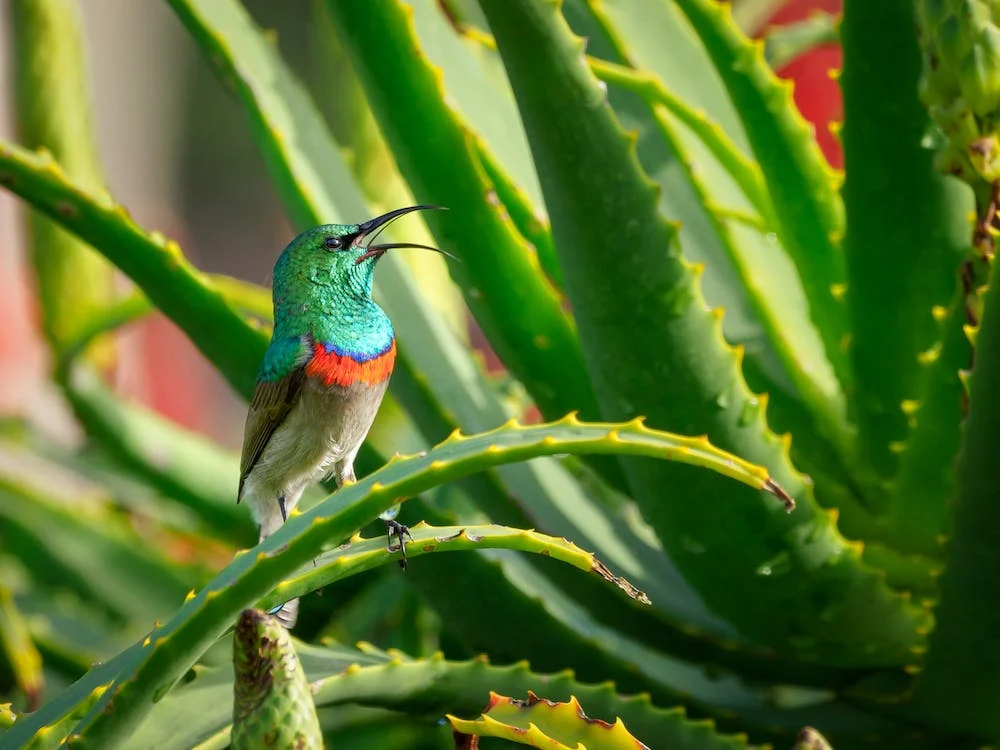The Greater Double-collared Sunbird, also known as the Cinnyris afer, is a small species that belongs in the sunbird family. This family of small passerine birds from the Old World are brightly colored, often with iridescent feathers. The Greater Double-collared Sunbird’s closest relatives include the Ruby-cheeked Sunbird, Seychelles Sunbird, Spectacled Spiderhunter, and Vigors’s Sunbird.
The Greater Double-collared Sunbird, along with many other bird species, was first described by Carl Linnaeus in 1766. He is referred to as the father of modern taxonomy due to his outstanding contributions in the fields of taxonomy, zoology, and botany.
This colorful bird species can be sighted in the African continent, particularly In the gardens and forests of South Africa. The Greater Double-collared Sunbird has two subspecies, namely:
- a. stuhlmanni or Stuhlmann’s Sunbird
- a. prigoginei or Prigogine’s Sunbird
Since the Greater Double-collared Sunbirds occur in a wide range and their population is on a continuous, stable rise, the International Union for Conservation of Nature (IUCN) Red List classified the species as Least Concern.
Its seven levels of scientific classification are as follows:
Kingdom: Animalia
Phylum: Chordata
Class: Aves
Order: Passeriformes
Family: Nectariniidae
Genus: Cinnyris
Species: C. afer
The physical characteristics of a Greater Double-collared Sunbird
This small yet colorful bird is probably one of the most beautiful birds that you will find in the forest edges and fynbos of South Africa. Despite its slender size, its striking colors are what makes it a beautiful sight to behold.
An adult Greater Double-collared Sunbird stands only 14 cm long and weighs between 9 and 18 grams. An adult male possesses a glossy, metallic green head, upper breast, throat, and back. It has an extensive red band across the chest. A slim metallic blue band separates the green and head and red chest. The rest of its underparts are pale grey in color. Yellow feather tufts are present on its shoulders. Like other sunbird species, it has a long, decurved bill, which is black in color. Its legs and feet are black too.
This bird species shares most of its characteristics with the Lesser Double-collared sunbird, a bird that has a green head, blue band, and red chest band as well. However, the Lesser Double-collared sunbird has a smaller size, narrower red chest band, and shorter bill. The Greater Double-collared Sunbird’s calls are characterized by a hard chut-chut-chut, and the song is a high-pitched mixture of tweets and twitters, which are richer than the calls of a Lesser Double-collared sunbird.
The distribution and habitat of Greater Double-collared Sunbirds
The Greater Double-collared Sunbirds are endemic to the southern part of South Africa. They are primarily residents and semi-migratory birds who fly in the northeast of its area. These birds are commonly seen in fynbos, forest edges, valley bushvelds, coastal scrubs, and rural gardens. They also frequent in a wide range of habitats such as subtropical/tropical moist lowlands, shrublands, riverine scrubs, and grasslands. They do not frequent the interior of forests. They prefer edges and the top of the canopy.
The behavior of a Greater Double-collared Sunbird
The Greater Double-collared Sunbird is a diurnal bird that usually wanders alone or with a pair. It has short wings, but its flight is fast relative to its size.
Greater Double-collared Sunbirds breed all year round, peaking between July and November. They create closed oval nests that are constructed from lichen, grass, and other plant materials, assembled together with spider webs. The nests have side entrances; some even have porches that are lined with feathers. The nests are often targeted by brood parasites such as the Klaas’s Cuckoo. Brood parasites refer to animals that rely on others to raise their young. This particular strategy is common among sunbirds.
The male and female Greater Double-collared Sunbirds feed the young with insects, fruits, and spiders once the eggs are hatched.
The diet and eating habits of a Greater Double-collared Sunbird
A Greater Double-collared Sunbird is armed with a decurved, long bill that enables it to feed on nectar from flowers effectively. They are vital pollinators in South Africa’s ecosystems. Sometimes, a Greater Double-collared Sunbird takes on some fruits. It has a habit of hovering in front of the webs to feed on spiders. The Greater Double-collared Sunbird feeds on other insects, especially when they need to feed their young.
BOTSWANA BIRDS | SOUTH AFRICA BIRDS
NAMIBIA BIRDS | ZAMBIA BIRDS | ZIMBABWE BIRDS

